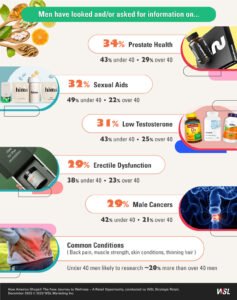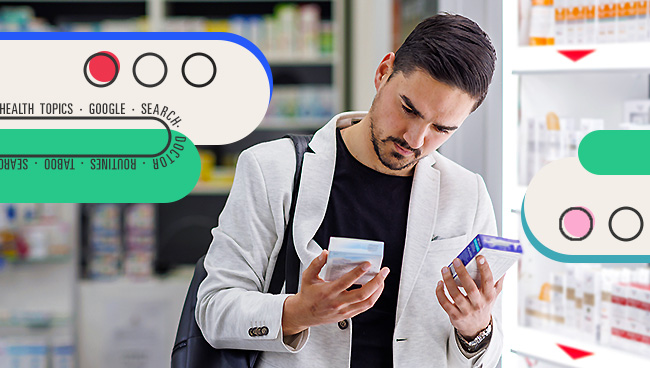Nearly one-third of all adult men seek wellness remedies for gender-specific ailments. Yet there is no easy-to-find, dedicated men’s wellness section in many stores. For our latest How America Shops® survey, we asked men which health conditions they have researched. Their responses, and the differences between pro-active health-conscious younger men versus men older than 40, indicate an emerging and overlooked retail opportunity.
Where Can Your Male Customers Find the Prostate Vitamins?
There are women’s wellness and hygiene aisles in every store, why not something equal for men?
Women shoppers seeking retail remedies for menstrual pain or sexual lubrication can easily find them in clearly marked aisles. But when it comes to men’s wellness goods such as prostate health, immunity for men and more serious conditions like erectile dysfunction and low testosterone, consumers typically need to scour the shelves for products that are mixed into broader categories, like the vitamin aisle.
The result: men are turning to the internet, where there are remedies organized by condition and where they can get discrete, professional guidance from a physician or pharmacist. And plenty of direct-to-consumer options for male-specific wellness needs are emerging, including Manual, Mate, Hims and Numan.
Young Men, Especially, Are Proactive About Their Health
For our recent How America Shops® report, “The New Journey to Wellness – A Retail Opportunity,” we asked male shoppers which wellness categories they sought help for in the store. Note the differences between older and younger men, suggesting that men younger than 40 are more likely to research and buy products for themselves for prevention, rather than treatment. The opportunity: younger men are creating a retail opportunity for their wellness.
Of the male-specific conditions, here is the surprising demand. Note that there is a consistent 10-to-15 percentage point gap between men under 40 and those over 40.
- Prostate health – 34% of men looked and/or asked for information on prostate health, either for themselves or someone else. In a twist, 43% of these men are younger than 40; 29% are older than 40.
- Sexual aids – 32% of men sought these category solutions for themselves or another person, potentially a partner. The figure ratchets up to 49% among men who are younger than 40, not surprisingly. But note: 22% of men older than 40 seek these solutions, too.
- Low testosterone – 31% of men sought information or solutions for this condition for themselves or someone else. Again, men under 40 represent more demand – 43% vs. 25% of men older than 40.
- Erectile dysfunction – 29% of all men looked for or asked someone specifically for information on ED. Unexpectedly, 38% of these men were younger than 40; 23% were older than 40.
- Male cancers (testicular and prostate) – 29% of all men sought information for this stressful health issue, with men younger than 40 being twice as likely to seek information – roughly 42% vs 21% of those older than 40. The average age of men diagnosed with testicular cancer is 33[1].
- And let’s not forget more common conditions – Men also are seeking remedies for back pain, muscle strength, skin conditions and thinning hair. Men under 40 are more likely to research these conditions than men over 40 by about 20 percentage points.

Ask: Is Your Wellness Solution Slowing Men Down?
Over and over, our research has shown that men rank speed very high when it comes to the stores they shop – 40% want to get all their shopping done in one trip[2].
If there is no dedicated men’s wellness section and the products are blended in with other remedies – or the line for the pharmacist is too long or too public, the odds are men will go to their smartphones right in your aisle.
Based on our results, here are four approaches retailers can take to ensure their male shoppers, especially younger shoppers, leave with a wellness purchase:
- Just put up a sign that states “men’s health.” It’s overly simple, but retailers can dedicate a section of an aisle, or an entire endcap, to men’s health issues. The key is bold signage that makes it clear the products are formulated for conditions most important to men.
- Give male shoppers the keys to care. We’re talking digital keys here, in the forms of posted web addresses or QR codes in the general wellness aisle that can direct shoppers to male-specific health categories and information on the retailer’s website. The sign can be specific: “Looking for male sexual and prostate health products? Scan this code.” It also has the option of being more discrete.
- Enroll the pharmacy staff. In our report, “Caution! Retail Curves Ahead,” 60% of consumers said they plan to get flu vaccines, and most will get them at retail pharmacies. What prevention and symptom-relief opportunities are there for men to browse while waiting for their shots? Messaging at the counter, and prompts by the pharmacy staff, can encourage men to ask about male-related conditions.
- Bring in the experts. Online or in-store education programs, headed by local physicians, noted wellness gurus or your telehealth pharmacist are like wine tastings for wellness products. Shoppers who attend these free events can learn about conditions, ask questions and receive discounts on select products if they purchase them that day.
There’s Much More In Our Report
To learn more about the specific types of information men sought, where they went to find insights, who is buying their wellness products and the regimens they are establishing to manage their health, get our report, “The New Journey to Wellness – A Retail Opportunity.” You can access it and all our How America Shops® findings here.


